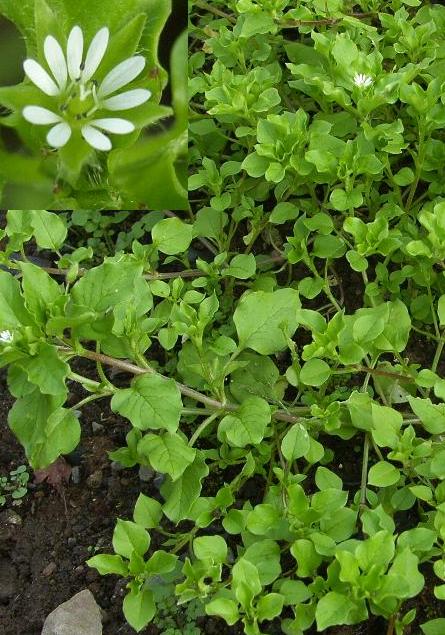Common ChickweedScientific Name : Stellaria media |
This is an annual, but is also ephemeral as it can mature and produce seed in 5 to 6 weeks, so there can be several generations in a year; later germinated plants may overwinter. It forms a dense mat, smothering other plants; flopping stems root as they spread. Seed can remain dormant for many years, germinating when the ground is cultivated and this can be for up to 25 to 40 years. Some viable seed have been recovered from bird and animal droppings and ants are known to carry them away as well. However, if ground is cultivated for a few years and the plants are never allowed to mature, the amount of germination reduces to very little. It is probably the most common weed worldwide.
It is an alternative host to the Cucumber Mosaic Virus which also affects other cucurbits such as courgettes or marrows - the leaves go yellow and the plants die back.
When growing well the lush top-growth has a sweet, pea-like flavour and it can be added to
salads, made into a soup or a soup garnish. It is a source of vitamins A, B and
C, calcium and potassium so makes a tonic for poultry and caged birds - hence the common name.
Crushing a
few leaves to release the sap and rubbing onto the skin, should relieve irritation. An infusion taken
twice daily should ease a cough or applied externally as a wash for wounds,
rashes and sores. The most commonly quoted medicinal use is as a poultice applied to reduce swelling.
It can be found in flower all year round, and is able to mature to seed at any time as well. The flowers are small, white and star-like with about ten petals and the pointed sepals behind them are longer.
Height - up to 30 cm, but usually prostrate.
Hoe or hand pull, the top-growth is brittle and the roots are tenacious. Trace the
stems back to the growing point and loosen the roots - though being an annual these do not have to be completely removed, just the growing point. The growing point can remain if the plants are pulled away, so they may regrow. Dispose of uprooted
plants if flowers and seedheads are present. Regular hoeing of the seedlings for a few seasons reduces the frequency of germination and it can virtually disappear unless deep cultivation brings up more seeds. A weed burner kills off the topgrowth and it should not recover, this can also destroy some of the seeds on the surface as well.
Weedkillers to use:-
A residual herbicide will supress germination in non-cultivated areas.
Paraquat and Diquat have contact action, killing the top growth, they should be applied before flowering.
